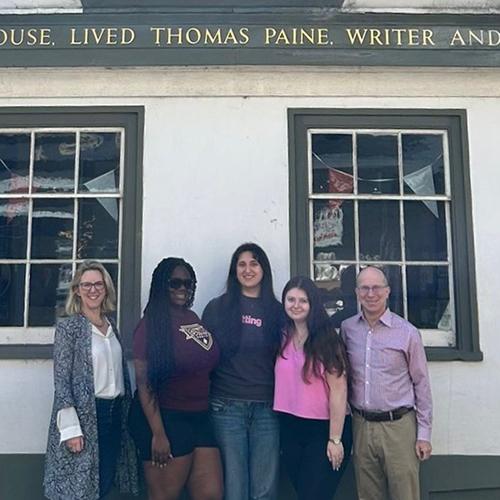Catholic Heritage
Iona University is rooted in a long history of Christianity, learning and service, and in the vision of two remarkable men who believed in the transformational power of education.
Iona’s ancestry dates back to 563, when Columba, a member of the Irish ruling class, gave up the wealth and power afforded to him by birth and became a monk. He founded an island monastery on the Isle of Iona off the coast of Scotland, which became a home to scholars and a center for religious study and learning.
Over 1,000 years later, Edmund Rice, an Irish businessman following in Saint Columba's footsteps, gave up his position and wealth, and devoted the rest of his life to prayer and education of the poor, young boys of Ireland. When others joined Rice in a commitment to a life of prayer and teaching, he formed the Congregation of Christian Brothers.
It was in the spirit of this heritage that the Catholic order of educators, the Congregation of Christian Brothers, founded Iona College in 1940. In 2022, Iona officially changed its status to become Iona University.
When the Christian Brothers started their new elementary and secondary schools in New Rochelle in 1916, Br. Ignatius Doorley named them "the Iona Schools" after St. Columba's island monastery. A short sketch of St. Columba's life shows why this was an inspired choice:
In 521, Columba was born into an Irish ruling family. Setting aside his royal claims, he chose to become a monk. In this early medieval period, Irish monasteries flourished as seats of Christian and secular learning. Monastic students followed a classical curriculum, including the Latin and Irish languages, rhetoric, logic, geometry, astronomy and music. In addition to theology and scripture, monks studied and transcribed the works of Virgil, Horace, Martial, Juvenal and other Latin authors, which they then transmitted to the rest of Europe on missionary journeys.
Columba quickly emerged as one of the most influential leaders of this monastic movement, founding monasteries throughout Ireland, including those at Derry, Durrow and Kells. In 563, whether from missionary zeal or a self-imposed exile, Columba took twelve companions and sailed north from Ireland until his homeland disappeared below the horizon. They made landfall on Iona - a slender island off the coast of Scotland - and started a new monastery.
For the remaining thirty-four years of his life, Columba, taught, studied, prayed, and led his monks, building on Iona a vital center of Celtic Christianity. In Iona's scriptorium, scribes transcribed hundreds of manuscripts, and created - many scholars believe - the Book of Kells (an illuminated text of the Four Gospels). Monks traveled out from Iona to evangelize the Picts and other tribes in the north of Britain, and founded dozens of new churches and monasteries - as far off as Italy. Foreign students traveled to Iona for studies. For two hundred years after its founding, Iona reigned as a powerful incubator of spirituality, learning, and missionary spirit.
A series of Viking raids around 800 devastated the monastery; the surviving monks withdrew to the Irish mainland. In the thirteenth century, Benedictine monks and nuns and Augustinian nuns founded abbeys on the island; these flourished until the Scottish Reformation, when they were dismantled and abandoned. Today, travelers can visit Iona, walk its hills, examine its medieval buildings and high crosses, make retreat, or simply rest in its spirit.
His Holiness John Paul II beatified Edmund Ignatius Rice on October 6, 1996, in St. Peter's Square. Speaking of Blessed Edmund Rice, the Pope stated, "Here we have an outstanding model of a true lay apostle and a deeply committed Religious. ... Today, his spiritual sons, the Christian Brothers and the Presentation Brothers, continue his mission: a mission which he himself described in this simple and clear intention: 'Trusting in God's help, I hope to be able to educate these boys to be good Catholics and good citizens.’"
Blessed Edmund Rice was beatified after the Church investigated and recognized a medical miracle that was the result of people praying to the Founder for his intercession with God. The miracle was a recovery from a terminal medical condition that the patient's doctors could not explain.
With beatification, Edmund Rice was declared a "blessed" member of the Church. This allows a limited form of veneration. Another miracle is needed between beatification and canonization, at which time a candidate would be declared a saint.
The late John Cardinal O'Connor, speaking at St. Patrick's Cathedral on September 21, 1996, at a Mass celebrating the beatification of Edmund Rice and the 90th anniversary of the Christian Brothers in the United States stated, ''It would be sad, but it's conceivable that we would not be here if history ended with Edmund Rice's death, but his legacy, his spirit, is so dynamically alive here in the United States today...and certainly, as I can testify, here in New York.''


